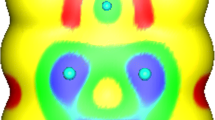Abstract.
A variety of atomic and molecular properties can be expressed in terms of the electrostatic potential. These include energies, covalent and anionic radii, electronegativities (chemical potentials) and a variety of properties that depend upon noncovalent interactons. We present a survey of such relationships, which may be exact or approximate; they may involve the potential in three-dimensional space, along the axes between bonded atoms, at nuclei or on molecular surfaces. Thus, the electrostatic potential, which is rigorously related to the electronic density by Poisson's equation, can be regarded as, effectively, another fundamental determinant of atomic and molecular properties.
Similar content being viewed by others
Author information
Authors and Affiliations
Additional information
Received: 6 March 2002 / Accepted: 15 May 2002 / Published online: 29 July 2002
Rights and permissions
About this article
Cite this article
Politzer, P., Murray, J. The fundamental nature and role of the electrostatic potential in atoms and molecules. Theor Chem Acc 108, 134–142 (2002). https://doi.org/10.1007/s00214-002-0363-9
Issue Date:
DOI: https://doi.org/10.1007/s00214-002-0363-9




